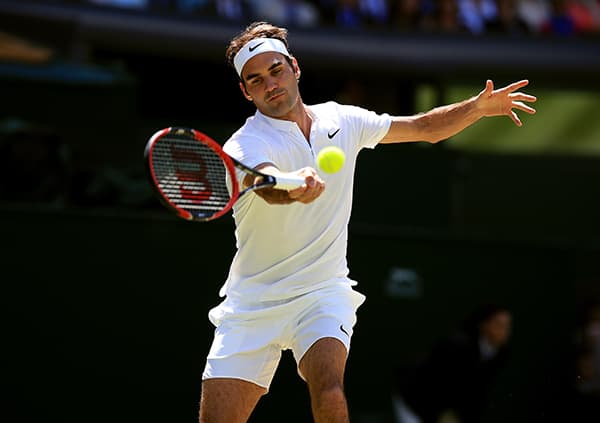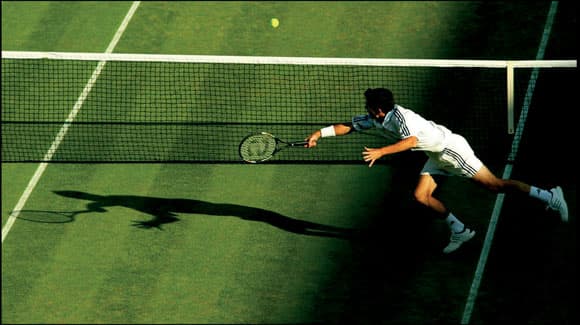
Cameron Norrie in action against Jo-Wilfried Tsonga on day one of the Wimbledon Championships at The All England Lawn Tennis and Croquet Club, Wimbledon. Image by Adam Davy/PA Wire
Wimbledon is officially upon us again. As one of the few major sporting competitions that lets members of the public freely bring their cameras into the grounds (granted, with a few rules in place), the oldest tennis tournament in the world makes for a fantastic opportunity for enthusiastic action and sports photographers to test out their skills.
It has to be said, a lot of photographers tend to shy away from shooting sports photography because they say they don’t have the equipment needed to make really great action photographs. In some respects this is true. The very best in action photography can take a lot of skill and good equipment to produce, but this really need not be a barrier keeping new photographers or the occasional action shooter, from trying their hand at it.
Here are some tips to for how to photograph Wimbledon like a pro.
What to bring

Image by Donald Miralle /Sports Illustrated/Getty Images
Camera: Probably the top thing to check is that your camera of choice has the option to select a high ISO value. This will allow you to shoot at fast shutter speeds to freeze the action, even when the light isn’t great.
Pro action photographers use very fast auto-focus cameras, but this doesn’t mean that good shots can’t be taken with the slower entry-level systems or even with focus control switched to manual. In fact, in some cases, the pros prefer to turn off their AF systems and use manual focusing. This works best when you know your subject is going to be a specific distance from the camera.
[collection]
Lenses: Generally speaking, you’ll want to pair your camera with fast (wide maximum aperture) and long lenses so you can get in close and maintain a high, action-freezing shutter speed. That said, most telephoto zooms are suitable for outdoors events if high ISO settings are used. However Wimbledon’s rules mean that you’re not allowed to take in lenses longer then 300mm. But they don’t relate this to a particular sensor size, so using an APS-C or Micro Four thirds camera will get you longer effective ‘reach’.
Image stabilisation or vibration-reduction lenses are also handy. Great for shooting in low light, they enable you to continue shooting with slower shutter speeds, which can be useful for conveying a sense of motion to your pictures.
Tripods and monopods: In the interest of getting the sharpest sports photography images possible, it’s usually a good idea to use a tripod or monopod. It’s not technically against the rules to take either in to Wimbledon, but you ‘must not inconvenience any other person in the Grounds’, which means you can probably rule out trying to set up a tripod.
However, you’ll find that camera shake becomes an issue when you start to use long focal length lenses. A monopod will go a long way to solve these problems, ideally fixed to the tripod collar of your lens if it has one. Just don’t get in anyone’s way!
Spare batteries: Don’t forget that your camera can get through batteries quickly, particularly if you shoot a lot of frames. Make sure your batteries are fully charged and bring a spare stashed in a side pocket of your bag.
Memory cards: Sports photography has a higher ratio of shots taken to shots used, than other types of photography, so ensure you have plenty of card space to hand.
What to look for

Roger Federer plays a textbook shot. Image by John Walton/PA Wire
See the future
When it comes to sports photography, timing is crucial. The most important thing to remember is that the photographer’s job to just to watch what’s happening, but to anticipate where and how the action is going to unfold, and then be ready to capture it.
There is an old sports photographer’s adage that says: ‘If you see the action through the viewfinder then you’ve lost it’, and this rings true. At the moment of exposure for most digital users, the viewfinder goes blank to allow the shutter to open. So, if you’ve seen the action then you’ve probably missed your chance to record it.
Think about the tennis court and the tactics the players are using – then you can pre-empt where some of the action will be, and make sure you are in the right place at the right time for the perfect shot.
What makes tennis tennis?
It’s always a good idea to be looking for moments that tell a story and have a strong sense of narrative. Since you’re trying to capture a subject which is narrative-driven by its very definition, this is never truer than for sports photography.
Think about the parts of the sport that really represent the action – for tennis, you’re looking at the motion of the serve, the drama of diving to make an impossible shot down the line or the frenetic action of the drop-shot.

Maria Sharapova prepares for a shot. Image by Neil Tingle/Alamy Stock Photo
It’s worth remembering when you’re analysing the action, though, that you’re not just looking for the most aesthetically representative moment – you’re also hunting for one that can most successfully captured by your camera. For example, there is a point at the top of the toss-up for a service where the ball’s upward motion ends and is frozen in the air for a split-second – this is much easier to capture than flurry of movement as the serve is completed.
Beware the background
Watch out for distracting backgrounds. It’s true that some of the distraction of the crowd in the background can be minimised by using a shallow depth of field, but it is best to have as clear a background as possible. This will help to make your subject stand out.

Andy Murray reacts after winning the first set during his match against Alexander Bublik on day one of the Wimbledon Championships. Image by Steven Paston/PA Wire
Go behind the scenes
Don’t forget that there are stories to be had behind the scenes as well. It could be worthwhile following the progress of one individual through the warm ups, the big event and the aftermath, be it jubilation or despondency. Shoot high, shoot low, but make sure you change your angle of view. Make the most of the location by moving around to find new vantage points.
Also ensure you vary your shots. Use different focal lengths so that at the end of the event you have a combination of close-up, mid-range and long shots. A couple of good-quality zoom lenses can help cover an astonishing range of focal lengths.
How to shoot
Freeze the action

Belgian Yanina Wickmayer pictured during a training session ahead of the 2017 Wimbledon grand slam tennis tournament. Image by Benoit Doppagne/Belga/PA Images
The holy grail for most sports photographers. Since flash is strictly forbidden at Wimbledon, photographers have to rely on a combination of aperture, shutter speed, ISO value and the natural light in the scene.
Put simply, to be able to use speeds that will freeze motion, you need a fast lens, high ISO setting and good light.
Slow the shutter speed
Photographers also like to use slower shutter speeds to capture moving subjects. The blurry results often communicate a feeling of frenetic motion. The shutter speed, direction of the motion through the frame, the lens length and the speed of the subject all govern the amount of blur in the final image.
Try a range of speeds with the same subject. Your tests will give you a starting point that you can use next time you are shooting a similar subject.

Image by Christopher Burns
Focus on the action
Two AF modes are found on most cameras: single and constant auto-focus.
In single mode when the button is held halfway down, the lens focuses on the main subject. If the user wishes to change the point of focus then they will need to remove their finger and repress the button. If the subject moves, while using this mode, then you have to refocus.
The constant or continuous focusing mode also focuses on the subject when the shutter button is half pressed, but when the subject moves the camera will adjust the focusing in order to keep the subject sharp. This is also called focus tracking.
Some AF systems have taken this idea so far that they have ‘pre-emptive focusing’ features that not only track the subject but analyse its movement across the frame and try to predict where it will move to. This helps to keep the main subject fully sharp.
Each mode has its uses. Single focusing is handy if you wish to focus on a zone into which the subject will appear. Constant is more useful for subjects that move more randomly.
Continuous shooting

Most digital cameras these days have the option to shoot a rapid sequence of pictures. The rate at which sequential images are captured and the total number possible for a single burst varies, but this is often a great choice for capturing sports – shooting a burst of images and checking for the best frames afterwards is a very effective method of catching important moments.
On the other hand, shooting all those images can slow down your camera and eat through your storage space and battery at an astounding rate, so make sure you’re prepared to swap!








